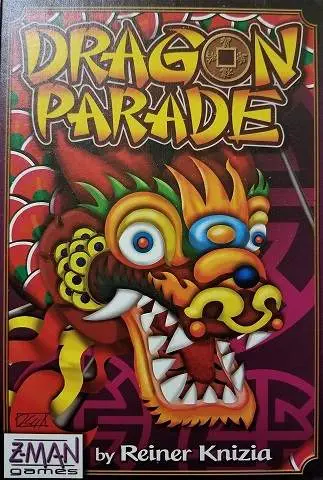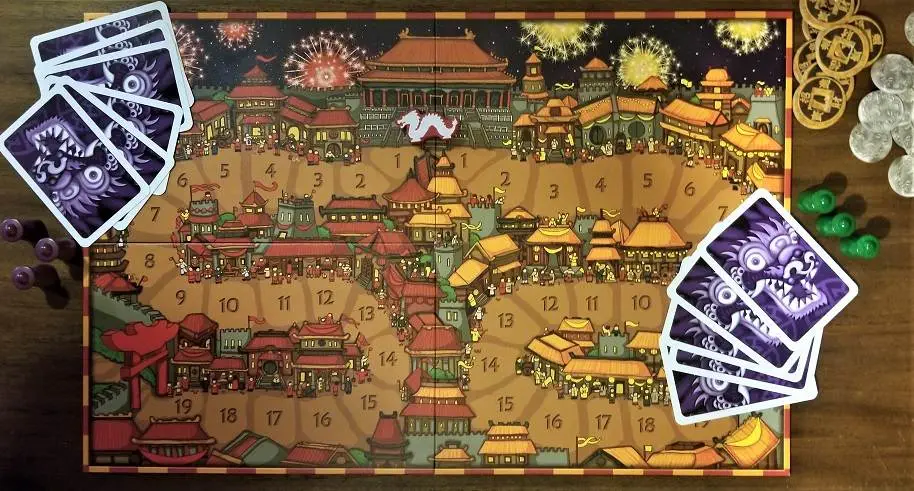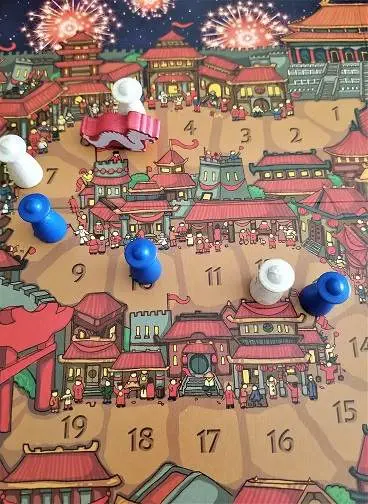
Representing power, wealth, and wisdom, the dragon is a very prevalent symbol in Chinese culture. The Dragon Dance is commonly performed during festivals and celebrations and is believed to scare away evil spirits and the bad luck associated with them, ushering in good luck and wealth instead. During the dance, a team carries the colorful fabric dragon on poles with the lead dancers maneuvering the head in dips, lifts, thrusts, and sweeps while the rest of the dancers emulate the river-like movements of a dragon’s body. These bustling events are a conglomeration of vendors, spectators, technicians, and the performers themselves. In Dragon Parade, players will take on the duty of not only attracting income from the guests, but of controlling the dragon dancers’ movements as well.
Dragon Parade is a 2-5 player game that was released in 2007 by Z-Man Games. Designed by Reiner Knizia, this colorful card game features artwork from Joshua Cappel. Knizia is known for many award-winning games such as Blue Moon City, Keltis, and Lost Cities. Cappel is both a game designer and an artist. Some of my favorites that he has designed include Haunt the House and Merchants & Mauraders: Broadsides. Besides Haunt the House, Cappel’s illustrations can also be found in quite a few other games including Fossilis, The Kringle Caper, and Scoville.

Before the parade can begin, players must first set up the board by placing it in the middle of the play area with the dragon meeple on the Forbidden City space. The red and yellow gate cards are shuffled together and each player is then dealt a hand of six cards. Players will also receive three “street seller” pawns in the color of their choosing. All remaining cards and pawns are returned to the box. The coins are placed near the board and within reach of all players. How to choose the first player is entirely up to the group, but we tend to pick the person whose Chinese Zodiac symbol matches/is closest to the current year. For example, today is the beginning of the Year of the Ox and I was born in the Year of the Tiger, so my birthday is closer than that of my partner who was born in the Year of the Monkey, which means I would go first.

Dragon Parade is played over several rounds equal to the number of players. During each round, players will take turns playing a card from their hand, moving the dragon dancers, and then placing one of their pawns. Pawns are placed on either the red or yellow path in any space that is not currently surrounded by other pawns or already occupied by one. The dragon meeple is moved along the path based on the number and color of the card that is played. The dragon will always move towards the gate matching the color of the played card, which means the dragon can be moved backward by playing the opposing color. After three of such turns, all pawns will have been placed. Next, players will discard two of their remaining cards before making one final attempt to position the dragon closest to their sellers by playing their last card. If the dragon reaches one of the city gates, the game ends immediately. Otherwise, once all cards have been played and the dragon dancers have come to a stop, points are scored based on pawn proximity to the dragon.
In addition to feasting on dumplings, handing out our hongbao, and watching the lion and dragon dances, we tend to celebrate Chinese New Year playing a few themed games. This year, we decided to play a game that doesn’t come off of the shelf very often and share it with our readers. Though Dragon Parade does not have a lot of deep strategies, it is still light enough that we play it more for the celebration of the holiday and theme than if we were looking for a more intense experience. One of my favorite artistic elements of the game is Cappel’s use of color to easily denote the two paths. The traditional colors for Chinese New Year are red and yellow. The red is used to symbolize luck, joy, and happiness while the yellow symbolizes prosperity and power. These two colors are split on the board between not only the left and right paths but also the artwork used on each respective side. The buildings and fireworks are depicted in the colors of their corresponding path. If you’re looking for a light and quick family game, Dragon Parade is a good choice.
All photos of Z-Man Games products were taken and edited by Krista.